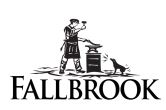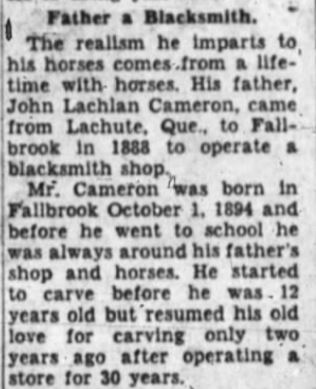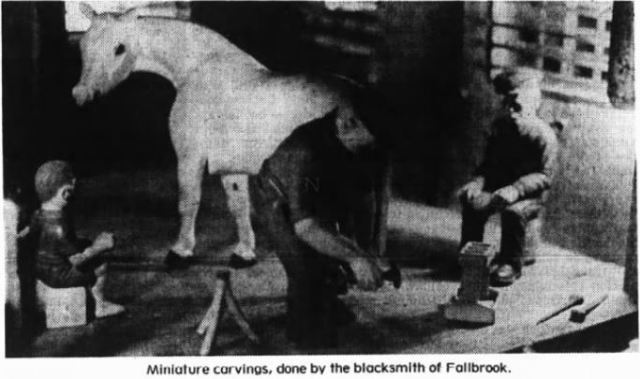“When you are young, keep company with the old;
When you are old, keep company with the young;
In this way, you never get too far to one side.”
Walter Cameron

Sometimes we look at a painting or sculpture, and we wonder what inspired the craftsman to create such a masterpiece. For one local artist, Walter Cameron, this is not the case. Walter was born and raised in one of the most picturesque spots in the country. Like many communities in Lanark County, Fallbrook is situated near several rivers and streams, and in fact, is named after the Fall River, that flows right through the community.

Although some would argue that the autumn is the prettiest time of year in Fallbrook, I would have to say that the spring, just after the snow melts, and nearby Bolton Creek, and neighbouring rivers of the Clyde, and the Mississippi, show their true spirit. It’s the fast, powerful force of the waters around Fallbrook, in the early part of the spring, that reminds us how this water powered the mills back in the old days. At one time in Fallbrook, there was a carding mill, a shingle and saw mill, two wooden mills, and a grist mill, harnessing the energy from the rivers to produce goods.
In the years to come, however, it may not be the mills that are remembered, it will be the blacksmith shop. Walter’s father, James Lockland Cameron, came to Fallbrook from Lachute, in 1888, and set up his blacksmith trade, in a small wooden structure, built by the founder of Fallbrook, William Lees, in 1865. Alongside the blacksmith shop, his father built a woodworking shop, and in its busiest time, employed five men. They built sleighs, cutters, and buggies in the wood shop, and made ploughs in the blacksmith shop before there were motorized farm tractors.
Walter’s father – James Lachlan Cameron, passed away in March, 1950, age 95:

“The Perth Courier”, March 23, 1950, p. 3
At the height of the blacksmithing business, Walter once estimated that they were using 100 pounds of horse nails in a month. He began to work for his father in the shop in 1912, at the age of 17. He worked at the trade for many years, but as the horseless carriage became increasingly popular, the blacksmith trade began falling off, by 1935. He carried on with his trade as long as he could, but finally retired in the 1940’s, when cars became ‘king.
“In 1925, he married the former Isobel Blair, of Brook. They have a son, Graham Cameron, who works with the Department of National Defence, in Ottawa.”
“The Ottawa Journal”, Dec. 14, 1957, p. 17
Maybe it wasn’t a complete loss when Walter retired from his ‘smithy’ shop, because it meant that he had some spare time on his hands. Although whittling objects from wood had always been a hobby of his, he began working more seriously on his wood carvings in 1956.

‘Ottawa Journal’, Dec. 14, 1957, p. 17



May, 1958, Walter makes tiny shoes to fit his carved horses
By the early 1960s, Walter was already becoming well known for his wood carvings. He carved mostly cows and horses, but also did carved bulls and deer. He began to make a name for himself, and was asked by Upper Canada Village, to carve some animals for them to display at the park. Considering all of the intricate detail in the carvings, it was surprising that he used a simple jack-knife to do most of his work. He loved to study the animals that he carved, and he and his wife attended all of the local fall fairs, where he sat for hours, observing the animals.

“The Ottawa Journal”, Sept. 3, 1966, p. 37

“The Ottawa Journal”, Sept. 3, 1966, p.37

“The Ottawa Journal”, Sept. 3, 1966, p.37
Many people in the area were busy in 1966 with ‘Centennial Projects’, to celebrate the 100th anniversary of confederation in 1967. Walter’s project was to remember the Ox, and the contribution made, by this humble animal, to the early days, when the pioneers settled the area. The back of his ox-shoe plaque reads:
“Oxen played an important role in developing the early Canadian frontier. These slow-moving, stalwart animals, which were a common sight around the time of Confederation, required individual shoes, for each half of the cloven hooves. This shoe has been hand-forged, by Walter Cameron, in his Blacksmith shop, at Fallbrook, Ontario, which he and his father operated, for some 90 years. Eleven Canadian woods have been selected, to display these shoes, symbolic of the Canadian scene, of a century ago.” Walter Cameron

“The Ottawa Journal”, June 12, 1972, p.5

“The Ottawa Journal”, Oct. 27, 1973, p. 34

“The Ottawa Journal”, Oct. 27, 1973, p. 34
He carved every fall, and through the months of long winter evenings, in their home, near the blacksmith shop. He always used good basswood, and some of his pieces were extremely intricate and complex. He once carved a small wooden box frame, and inside was a round ball, which could be rotated. It was carved from one block of wood. He also made wooden chains, also carved from one piece of wood. Of course carving cows and horses were his main artistic pursuit.



“His favourite tool is a 60-year old, Henry Boker, Jackknife. He observed that any boy in the early 1900s, who possessed a Henry Boker jackknife, was the envy of all his friends.”

Walter at the century-old forge in Fallbrook
One of his most interesting carvings, was a wooden miniature replica of the old blacksmith shop. It was complete with human figures, and depicted a horse, being shod. In order to forge the tiny horseshoes he had to first make miniature tools. The replica shows his father, seated on a nail keg, and nearby seated on a box is Walter’s son Graham, as a little boy. Also depicted in the scene is his favourite grey horse, being shod by Walter himself, with a tiny farrier’s hammer in his hand.

“The Ottawa Journal”, Aug. 14, 1971, p.43

“The Ottawa Journal”, Aug. 14, 1971, p.43

“The Ottawa Journal”, Aug. 14, 1971, p.43
Over the years, Walter became a local legend around Lanark County. He’d been featured on many different television programs in the 1970s and 1980s, such as: “Kingston Calendar”, “Four for the Road” “This Land” and “From Now On”. He was a frequent guest speaker at the Perth Museum, and he also gave tours of his blacksmith shop to both locals and tourists.

quote by Walter Cameron

Putting the final touches on the horseshoe
Walter’s shop became a regular stop, on what was known as ‘Byway Tour No. 3’, and it wasn’t unusual for over 200 people to visit, during busy weeks. There was even talk at one time of the National Museums of Canada buying all of Walter’s carvings, and turning his old blacksmith shop into an historical site. Over the years, thousands of people visited Walter in his shop. Often in the summer, there were bus loads of people coming to see his blacksmith shop. Walter never charged, although it took a great deal of his time. At one time he even had a sign posted with his opening hours each day.

By the time I met Walter, he was in his late 70s, and had reduced his opening hours to 9-11 a.m., and 2 – 5 p.m., daily. He was always firm about closing his place after the middle of August, so that he and his wife could attend local fairs – in Perth, Almonte, and Richmond. He said that he would sit and watch the horses and cows, and make sketches for his future wood carvings.
Walter was always keenly interested in passing on his knowledge of the blacksmithing trade to the younger generation. He often spoke at the local schools, and brought samples of both his tools of the trade, as well as his wood carvings.
I spoke with Walter, at the Perth High School, in May 1974. There was an Arts and Crafts Exhibit in the Resource Center of our school. I asked him about his carvings, and the drawings that he worked on, before he sat down to carve a new piece. He was a kind man, and eager to share his knowledge with those of us in the younger generation.
Many other local artists attended, set up displays of their work, and were there for the full day, to answer questions from the students. Along with Walter, were local Sculptor John Matthews, potter Marion Sinn, and the ladies of St. Paul’s United Church worked on a quilt. Other artists there were Dorothy Moffatt, Mrs. M.E. Forrester, Jill Lewis, Pat McGonegal, Miss C. Rice, Mrs. Meuser, Frank DeLaute, Vernon MacPherson, and Mrs. O. Scott.

Walter Cameron, April 1974, at the Perth High School

quote by: Walter Cameron, March, 1975
I could see by the way Walter smiled, and patiently answered question after question from the students that day, that he really enjoyed spending time with young people, and sharing his knowledge. He was fascinating to listen to, and told us that he had hung around the blacksmith shop as a young lad, and he used to watch the men and listen to the old stories. He talked about the old days, when cars were first driven on the roads, and they would hear one coming, the men in the shop would all stop working, and go out to watch. He told us that it was the opposite in the 1970s. People were used to cars, and when they heard a horse go by, they would run outside to watch.



“The Ottawa Journal”, June 16, 1979, p. 44

“The Ottawa Journal”, Mar. 24, 1975, p.2

“The Ottawa Journal”, Mar. 24, 1975, p.2


“The Ottawa Journal”, Mar. 24, 1975, p.2
Over the decades, thousands of people visited Walter in his shop, and his reputation as an artist and storyteller grew. To ensure that his story reached a wider audience, Audrey Armstrong, a neighbour of Walter’s, wrote a book about him in the spring of 1979 – “Walter Cameron, the Blacksmith of Fallbrook”. She tells in her book how he came from the time of the horse and buggy, carried through his life the memories and knowledge of the lost art of blacksmithing, and chose to share it with others.

Audrey Armstrong, author, and neighbour, with Walter Cameron 1979

Audrey Armstrong’s book, “The Blacksmith of Fallbrook”, Musson Book Company; First Edition edition (1979), ISBN 978-0773710306, 96 pages, paperback.

An excerpt of the book review by Henry Heald, ‘The Ottawa Journal’, June 16, 1979, pg. 44:
A man who appreciated prose and poetry, Walter Cameron read and memorized many of Longfellow’s poems
Walter was an admirer of Longfellow, and his poetry, and often recited his work to visitors, as part of the tour of his blacksmith shop:

(from an article by Dave Brown, in ‘Brown’s Beat’, may 19, 1979, pg. 27, ‘The Ottawa Citizen’.)
Walter Cameron lived a long life, and even on his 90th birthday, over sixty people turned out at his blacksmithing shop, to watch him shoe a horse. His hands were still strong, and his mind was as clear as ever. As usual, he answered questions, and shared a bit of his own philosophy of life, as he often did. He loved people, and wanted to share his knowledge and talents with them. In her book about Walter, Audrey referred to him as “Lanark’s Living Legend”. Walter truly was a living legend.

Walter Cameron, age 88, in June, 1982
“On his 90th birthday, a crowd gathered, to watch the old master shoe a horse.”

“He was a great teacher, and instructor, recalled his son, Graham. “An old, Scottish-style man, who was very exacting.”
Many of Walter’s carvings were auctioned off in the summer of 1987, by local auctioneer, Charles Hollinger

Charles Hollinger, Auctioneer, at the Walter Cameron estate auction, August, 1987
“Hundreds turned up to bid on his beautiful carvings.”

“The Cameron family donated one of Walter’s best-known works, a carved miniature blacksmith shop, to the Perth Museum, and kept a few carvings and mementos for themselves.”

carving by Walter Cameron
Walter Cameron often said his favourite quote was by Ghandi: “My life is my message.”

“Graham Cameron (Walter’s son), and David McCormick, present Walter Cameron’s wood carving tools to Keith Kerr, Reeve of Tay Valley Township”
“The Perth Courier”, July 11, 2013
Although he passed from this life, late in November, of 1986, Walter Cameron left a legacy, not only of his beautiful carvings, but the stories that he shared with many of us, and we are all the richer for having known, “the Blacksmith of Fallbrook”.
Early families of Fallbrook: Ashby, Bain, Blair, Buffam, Ennis, Donaldson, Foley, Keays, Playfair, McKerracker, Smith and Wallace
“Walter Cameron: Forging in Fallbrook”, an excerpt from ‘Lanark County Kid: My Travels Up and Down the Third Line’, ISBN:978-0-987026-16

*
Arlene Stafford-Wilson
Member, Association of Professional Genealogists
Honorary Life Member, Lanark County Genealogical Society
Lanark County Pioneer Families Humanitarian Award – 2023
Author of : “Lanark County Christmas”, “Lanark County Comfort”, “Lanark County Collection”, “Lanark County Calling”, “Lanark County Classics”, “Lanark County Connections”, “Lanark County Calendar”, “Lanark County Chronicle”, “Lanark County Kid”, & “Recipes & Recollections”
and, “Lanark County Kitchen: A Maple Legacy from Tree to Table”

Excellent local history story. Thank you for the details and the pictures. Walter forged more than metals and wood, he represented what it was to be a Canadian and a frontier!
Hello Susan. Thank-you for the kind words, and excellent comments on Walter Cameron.
purchased a small wooden carving of a soldier a few years ago at an auction signed Walter Cameron Fallbrook Ont. Canada. Just wondering if this might be from collection.
I worked at the Medical Centre at the hospital in the 70’s, and Walter would come in, and always had some words of wisdom for us. I bought one of his carved wooden boots, which was $13.00 plus tax of course. He was a very fine man.
Thanks for sharing your story, Shirley!